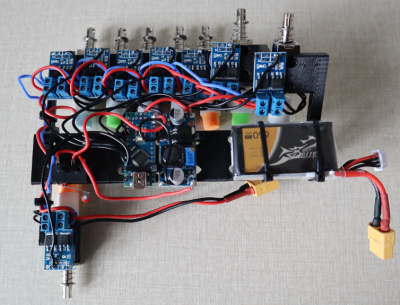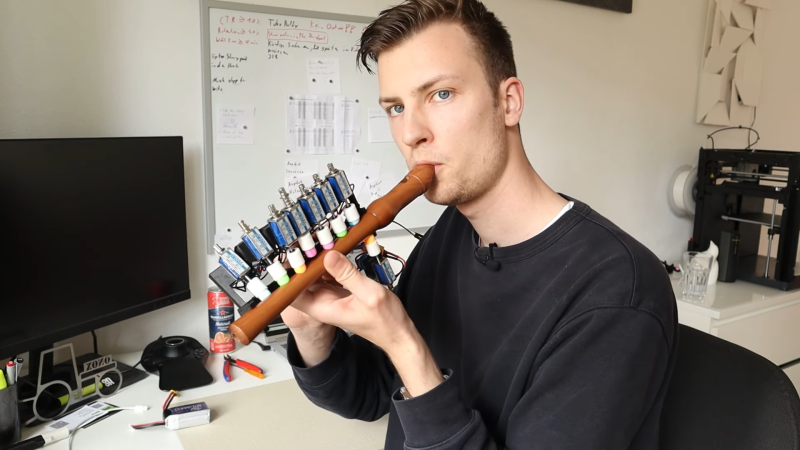Although many people might remember the recorder as just a simple instrument from their introductory music classes, it can nevertheless produce rich and varied melodies in the hands of a virtuoso like Frans Brüggen. [Luis Marx] also took music lessons as a child, but never progressed much beyond an elementary level. Instead, he preferred to spend his time honing his engineering skills, which eventually enabled him to get back into music.
Initially, he wanted to build a piano-playing exoskeleton, to marionette his fingers up and down the ivories, but had to bail on that one because of the insane complexity. So instead, he built himself a robot that helps him play the recorder. (Video, in German, embedded below, fast-forwarded to the recorder part.)
 A recorder has eight finger holes, which can be covered or uncovered in various combinations to produce tones. [Luis] therefore used eight solenoids, mounted on a 3D-printed frame, to actuate the finger holes. The basic idea worked, but getting the solenoids to fully cover the holes each time turned out to be a challenge: even a slight misalignment would cause air to leak past the plug and produce a horrible off-key sound.
A recorder has eight finger holes, which can be covered or uncovered in various combinations to produce tones. [Luis] therefore used eight solenoids, mounted on a 3D-printed frame, to actuate the finger holes. The basic idea worked, but getting the solenoids to fully cover the holes each time turned out to be a challenge: even a slight misalignment would cause air to leak past the plug and produce a horrible off-key sound.
After a lot of trial and error, [Luis] found foam earplugs to be a pretty good material for emulating human fingertips. He also discovered that relying on the solenoids’ spring tension to keep the holes closed was not reliable; a better solution was to flip the solenoids around and use the much larger force from their powered stroke to create an air-tight seal.
The solenoids are driven by an Arduino Nano through a set of MOSFET modules, powered by a lithium battery. [Luis] wrote some Arduino sketches with famous melodies like Beethoven’s Für Elise, which sound quite decent on the robo-recorder: perhaps not on Frans Brüggen’s level, but pretty impressive for a self-declared “music noob” like [Luis].
Many robotic musicians play instruments like pianos or xylophones. Instruments from the flute family are harder to automate, but it has been done before. We’ve even seen a MIDI-powered harmonica.

















Nice project! Controlling your breath is also necessary depending on what note you play though. Some soft silicone casts could help with better finger simulates. Some kind of padding for the recoil of the actuators could make them quieter. Some pwm ease in and out could also help.
Great. However, I see no code for generating the .ino, so writing the notes one by one must have been tedious. Next step : Recorder as MIDI output !
In the period from the 1890’s to about 1935, there were companies that made automated piano players, as distinct from player pianos. They were things you pushed up against the piano, that had, as postulated by this, one finger for each key and played songs. The one I’ve gotten to play with a little bit uses foot power to drive it, and like many of the more common player pianos, the foot treadles drive a rotary crank that runs three separate vacuum pumps 120 degrees out of phase with each other so the system has continuous vacuum. They’re pretty cool to watch.
(Side note, at least in the 1920’s, a lot of more conventional player pianos also had other instruments, notably drums and tambourines, stashed in the space beside the punched tape vacuum system that drove the piano keys. Those are pretty cool to work on as well.)
My grandfather’s neighbor had a garage full of nickelodeons. Not the sort of thing you should see as a child if you want to avoid a life-long fascination with absurd machines.
Ausgezeichnet! Tolle Mutter! Ich freue mich auf das nachste
The bottom two holes on the recorder are actually dual holes for c / c# and d / d#. More importantly, above the first octave, the thumb hole has to be “half-holed” or half covered. Half in this context can actually mean anything from half down to a sliver of an opening depending on the instrument, the note desired and the breath pressure required.
A cute project, perhaps, but it will never produce more than the simplest of tunes with a one-octave range, a third of the recorder’s capability.